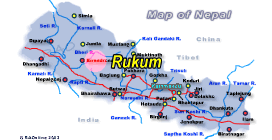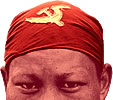 |
| Reports on Maoists |
|
|
 |
|
| Journey to Rukum |
 |
One question that I still can't answer after my visit to Rukum is this: have the people turned Maoist because they believe in Mao-Tse Tung thought or because of the sense of power they get with a gun in their hand? He looks like someone you'd meet on a Thamel street: boots, leather jacket and black denims. Smiling, he shakes my hand firmly and says: "Welcome to our restricted area." We had reached the town of Ghorahi in Dang on the first leg of a conducted tour of the Maoist-controlled district of Rukum and he is our local contact. |
We are meeting in a hotel and at one in the morning we meet "Comrade Pashupati", our guide from Rukum. Together we board the bus to Salyan at three in the morning. At Srinagar in Salyan, we get into another one and drive on through a treacherous road. Our guide looks nervous about being stopped by the police, but there is not a single policeman to be seen. At every stop, young men between 19-25 get on the bus and communicate in sign language among themselves. When we reach the roadhead of Bange Lakuri at three in the afternoon, the young men turn out to be members of a Maoist squad fully armed with handguns.
Far
to the north, the snowy summit of Sisne Himal towers like a pyramid. Here
we are in the heart of the Maoist-controlled hills of remote western Nepal.
After a short rest, we begin our trek passing a "martyr's gate" which we
are told was constructed with cement donated by a nearby Royal Nepal Army
camp. The army is here to build a highway from Salyan to Rukum. "We meet
the soldiers all the time along the trails," says a young guerrilla accompanying
us and who is carrying crude home-made bombs in his rucksack. "The army
is friendly so far, but they warn us that one day they may be fighting
us."
| One question that I still can't answer after my visit to Rukum is this: have the people turned Maoist because they believe in Mao-Tse Tung thought or because of the sense of power they get with a gun in their hand? |
He looks like someone you'd meet on a Thamel street: boots, leather jacket and black denims. Smiling, he shakes my hand firmly and says: "Welcome to our restricted area." We had reached the town of Ghorahi in Dang on the first leg of a conducted tour of the Maoist-controlled district of Rukum and he is our local contact. We are meeting in a hotel and at one in the morning we meet "Comrade Pashupati", our guide from Rukum. Together we board the bus to Salyan at three in the morning.
At Srinagar in Salyan, we get into another one and drive on through a treacherous road. Our guide looks nervous about being stopped by the police, but there is not a single policeman to be seen. At every stop, young men between 19-25 get on the bus and communicate in sign language among themselves. When we reach the roadhead of Bange Lakuri at three in the afternoon, the young men turn out to be members of a Maoist squad fully armed with handguns.
By evening we reach an insurgent camp. A man at a sewing machine is busy stitching camouflage uniforms, others are busy stencilling the hammer and sickle on red flags, still others are rehearsing musical performances, food is being cooked in large vats outside. It looks like preparations for a large festival are underway. The next morning we continue our journey northwards, greeted by villagers of all ages who have lined the trail to sing revolutionary songs, with fists raised.
The road is steep, and we are escorted by two armed Maoists. We stop for a rest at a deurali along the way, where we are offered yoghurt by an elderly shopkeeper. We ask her if the Maoists are extorting money. "We are not harassed in any way, after all we are all Maoists," she replies. On the border with Rukum District, we are handed over to escorts from the other side. We spend the night in the town of Khara, where 15 people were killed in a police raid exactly a year ago. Comrade Pashupati, who has been with us since Dang, still hasn't told us where we were going, and neither have we asked.
Villagers along the way look like they are not used to seeing the police on the road anymore, they know we are guests of the Maoists. We pass Maoist sentry-posts and gates with bright red banners proclaiming: "Long Live Marxism-Leninism-Maoism. Let's Move Ahead In the Great Task of Setting Up Base Areas." Finally, after another day of walking we reach our destination of Banphikot in Rukum. The next day, 20 December, long lines of people bearing red flags can be seen across the valley coming up the trail. The playground of the local school is festooned with banners for the first public meeting of the underground party to announce the setting up of the "District Peoples' Government".
By
noon, there are thousands of people from all over Rukum in the field, and
squads of "People's Army" dressed in combat fatigues identical to army
uniforms are squatting in the middle, their faces partly masked. One company
that was in action against the police in Kalikot and Baglung last month
during which 12 policemen were killed also arrives.
By afternoon, there are around 200 guerrillas and they stage a march past with rifles slung over their shoulders. The rifles are all .303 captured from the police, and some of the butts even have registration numbers on them. One is inscribed with the name of a police post in Jhapa. There are about 25 female guerrillas in the company, and they carry the lighter shotguns. The commanders have revolvers in their belts, and one even sports a sub-machine gun. The lower-ranking militia are not uniformed and carry long home-made muskets. The Maoists tell us that they are arming themselves with more modern weapons because they know they have to take on the Army. As night falls, the function marking the launch of the Peoples' Government gets going under electric lights powered by a government-run hydroelectric plant that also supplies power to the district headquarters of Musikot three hours' walk away. This is the irony of the Maoist-controlled areas, bridges are being built by the government, a health post is under construction, the post office still functions, the schools still have classes, the army is busy with highway building. The only absence is of the police, who withdrew after Maoist attacks on their remote posts and the guerrillas moved in to gradually take over.
The invited journalists are taken up on the stage and garlanded by the leader of the Maoist district government, Purna Bahadur Gharti. In their speeches, Gharti and others criticise the media for being sensational and incorrect. But they are more than solicitous towards us, praising what they say is our professionalism and commitment. "We used to be ruled, now we are the rulers," said the red-sashed Gharti in his speech, speaking clearly and forcefully with a fist slamming the night air. In an interview later, he tells us: "We are psychologically and physically prepared to take on the army. And we will declare a People's Republic of Nepal when we defeat the Royal Nepal Army and get rid of the Narayanhiti Palace."
The speeches go on till ten at night and are followed by a cultural programme with revolutionary performances patterned after local folk music and dance. This goes on till six in the morning, the villagers sit, huddled around, yawning and shivering with their children, but they watch the show in the chilly air. After 18 hours of non-stop speeches and performances, the programme ends, and the entire proceedings are broadcast over the Maoists' own 'FM station'. The Maoists are at pains to point out that they allow participation of representatives of other political parties at their rally. Local leaders of the UML and RPP are present, but there is understandably no Nepali Congress. One cadre is shooting the entire function with a Sony digital video camera.
Female Maoists are actively involved in the preparations at Banphikot, both as militia and as "People's Army" soldiers. Kamala Roka is the district president of the Maoists' women's wing, and she says: "The peoples' war has emboldened us women, it has given us confidence, and we are treated equally. However, once in a while you do see male dominance in our movement."
We snatch a few hours of sleep and at mid-morning are summoned to a press conference inside the classroom of a local school. Some of the questions are sharp and blunt, and the Maoists look a bit taken aback, and they hedge queries about strategy and tactics. The Maoists' local commander, Kal Bahadur Nath, is a deserter from the Royal Nepal Army, and he briefs journalists on the "People's War" saying: "We are forced to fight because we are exploited by feudal lords."
After the press conference, we are treated to a feast of rice and chicken curry, and the Maoists walk us down to the banks of the Sano Bheri river. The river forms the border dividing the "peoples' side" from the "reactionary side". Once we get over to the government-controlled bank, there is still no sign of any police presence, but on the far bank we can see Maoists in the sentry boxes waving back at us. We have left the armed world of Maoists, a district which regards the government in Kathmandu as its mortal enemy, and which is nurturing the next generation of Maoist supporters. But one question we cannot answer even after this three-day stay in Maoist territory is this: have the people turned Maoist because they believe in Mao-Tse Tung thought or because of the sense of power they get with a gun in their hand?
The district headquarter of Musikot is normally a three-hour walk uphill. But nearing the town, we hear firing in the distance- the police is shooting as it does nightly to show its presence, and the Maoists return sporadic fire from the surrounding hills. The locals along the way are too scared to let us stay, they are caught in the crossfire. Finally, we take refuge in a house where we are given corn patties with nettle soup. Next day in Musikot, we interview the local Chief District Officer, Netra Prasad Neupane, who sits at a desk with the Nepali flag behind him. "Unless the political parties become active at the village level, there is no way we can begin to solve the Maoist problem."
|
|

|

|